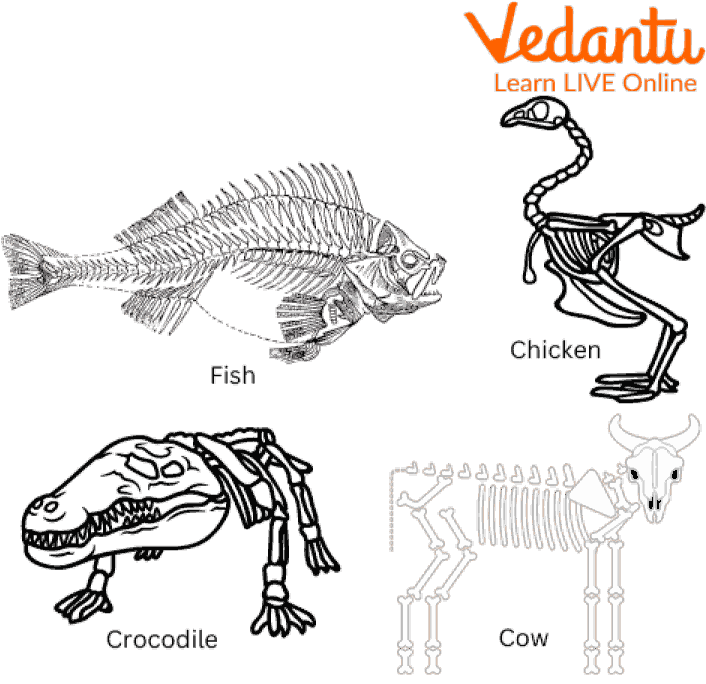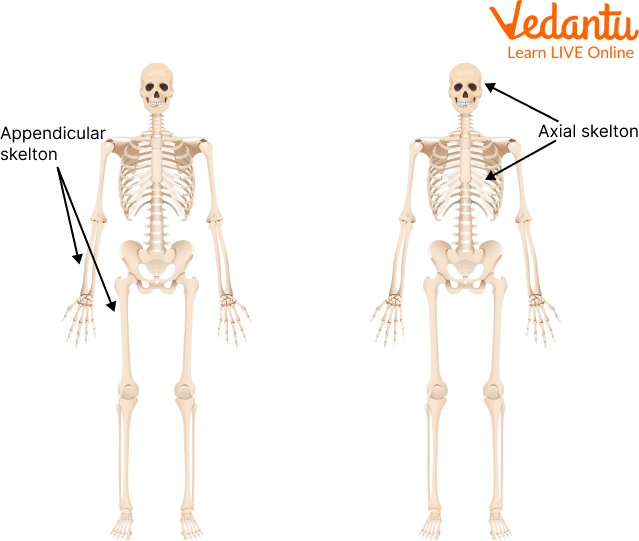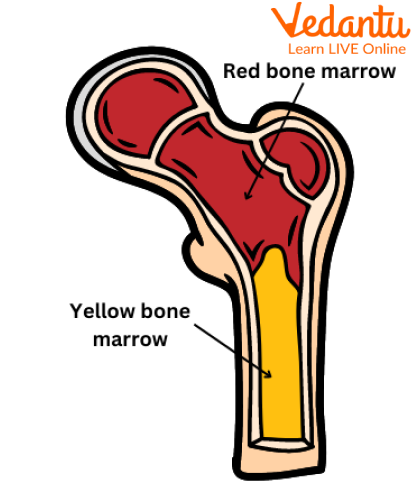




Overview of the Skeletal System for Kids
A skeletal system is an important group of bones. It’ll come as no surprise to you that this system consists of multiple bones, but you might not know that there’s so much more to it than just the bone itself. The skeletal system has a multiple of roles in the human body, from protecting the organs and providing points for muscle attachment, to storing minerals and producing red blood cells. Read this article till the end to discover ten interesting facts about the skeletal system for kids that you probably didn’t know!

Skeleton of Different Animals
How Many Bones are in a Child's Body?
We’re born with over 300 bones, but by adulthood, we have 206.
The skeletal system starts forming during the first trimester of pregnancy, and by the time you’re born, you already have over 300 bones! But over time, most of these bones fuse, and by adulthood, we have 206 bones.
The skeletal system of a newborn baby is different from that of an adult in many ways. For example, babies are born with extra bones, and their mobility is limited since they aren’t yet connected. Babies and children are more vulnerable to injuries since their bones are more likely to fracture and break.
Interesting Facts About Bones
In this article, we will learn interesting facts about bones.
Your skeletal system is made up of 2 parts: the appendicular skeleton and the axial skeleton.
The axial skeleton is found at the centre of the body and makes up the head and trunk (chest, abdomen, spine, and pelvis), and the appendicular skeleton is found at the extremities and makes up the arms and legs.
The axial skeleton consists of the skull, vertebral column, rib cage, and sternum.
The appendicular structure consists of the shoulder girdle, the upper limb, the pelvic girdle, and the lower limb.

Axial and Appendicular Skeletal System
There are 206 bones in the human body, some of which are fused due to the maturation process. The numbers may vary from person to person depending on their age, sex (women have thinner bones than men), and race.
Skeletal System Facts
Below are listed some important skeletal system facts:
One of the main functions of the skeletal system is to provide attachment points for muscles. There are various types of muscles in the human body, but they all have one thing in common: they are all anchored to bones by muscle tendons.
The skeletal system also allows you to maintain posture and balance.
The axial skeleton part of the human skeleton has 80 bones. It includes the vertebral column, the rib cage and the skull and helps us maintain our upright posture, by spreading the weight in the head and upper areas down to the lower areas near the hips.
The appendicular skeletal section of our skeleton has 126 bones. It includes the pectoral (shoulder) girdles, the pelvic girdle and the bones of the lower and upper limbs. Its function is for the movement of the body and to protect some organs.
Bones are constantly being remodelled. Bones are living tissues constantly being broken down and built up again. This is known as remodelling, which is crucial for your skeletal system. The remodelling process ensures that the bones get enough nutrients and minerals and stay strong and healthy.
Calcium is mainly stored in bones.
There are 2 types of bone marrow: red and yellow marrow. Red bone marrow produces red blood cells and platelets, while yellow bone marrow produces fat cells, cholesterol, and cytokines (special cells), which are proteins that help the body fight infections.
Men have larger and stronger bone and joint surfaces and more bone at muscle attachment sites.

Bone Marrow
The longest bone in the human body is the thigh bone called the femur.
The smallest bone in the human body is located in the middle ear. The staples (or stirrup) bone is only 2.8 millimetres (0.11 inches) long.
Like our skin, the human body's bones are also constantly worn down and re-made, to the point where every 7 years, we essentially have a new bone.
The area of our body with the most bones is the hand, fingers and wrist, where there are 54 bones.
Our teeth form part of the skeletal system but are not counted as bones.
Summary
To conclude all the learnings from this article we can say that human bones are very essential for our well being if not taken care of properly they can get prone to fractures and breaking. There are so many interesting facts about the skeletal system, and it’s worth delving into the topic in more detail. There is so much more to this system than just bones, and it’s amazing how much it does for us! Whether you’re a student studying anatomy or a curious reader wanting to expand your knowledge of the human body, these facts are sure to pique your interest. We hope you enjoyed reading this article, in case of any other doubts, feel free to ask in the comments.
FAQs on Skeletal System Facts
1. What are some interesting facts about the human skeletal system?
The human skeletal system is full of amazing facts. For instance:
An adult human has 206 bones, but a baby is born with around 300 bones that later fuse together.
More than half of your body's bones are located in your hands and feet.
The human hand, including the wrist, contains 54 bones.
Bones are living tissues that constantly rebuild themselves throughout your life.
2. What are the main functions of the skeletal system for our body?
The skeletal system performs several critical functions to keep us healthy and active. The most important functions include:
Support: It provides a rigid framework that gives our body its shape and helps us stand upright.
Protection: It protects our vital internal organs. For example, the skull protects the brain, and the rib cage guards the heart and lungs.
Movement: Bones act as levers that our muscles pull on to produce movement at the joints.
Storage: It stores important minerals, primarily calcium and phosphorus, releasing them when the body needs them.
Blood Cell Production: The bone marrow inside some larger bones produces red and white blood cells.
3. What is the longest and what is the smallest bone in the human body?
The longest and strongest bone in the human body is the femur, which is the thigh bone. It extends from the hip to the knee. The smallest and lightest bone is the stapes, located in the middle ear. It is about the size of a grain of rice and plays a crucial role in our ability to hear.
4. Why do babies have more bones than adults?
This is a fascinating fact of human development. A baby is born with about 300 bones, many of which are made of soft, flexible material called cartilage. This flexibility helps during birth. As the baby grows, many of these smaller bones fuse, or join together, to form the larger, stronger bones of an adult. This process of fusion reduces the total bone count to 206 in a typical adult skeleton.
5. If bones are hard and rigid, how do they allow us to move?
While individual bones are rigid, they are connected to each other at joints, which are the key to movement. Think of joints as hinges that allow for bending, twisting, and rotating. However, bones cannot move on their own. Muscles are attached to bones via tendons. When a muscle contracts, it pulls on the bone, causing movement at the joint. This teamwork between bones, joints, and muscles allows us to walk, run, and jump.
6. What is the importance of cartilage in our skeletal system?
Cartilage is a firm, smooth, and flexible connective tissue that serves as a cushion between bones at the joints. Its primary importance is to prevent bones from rubbing directly against each other, which would cause pain and damage. It allows for smooth movement and absorbs shock. You can also find cartilage in your nose and ears, giving them their shape.
7. Are all joints in the human skeleton movable?
No, not all joints are movable. While we often think of joints like the knee or elbow (movable joints), there are also joints that do not move at all. These are called fixed joints or immovable joints. A key example is in the skull, where the bony plates are connected by fixed joints to form a solid case that provides maximum protection for the brain.









